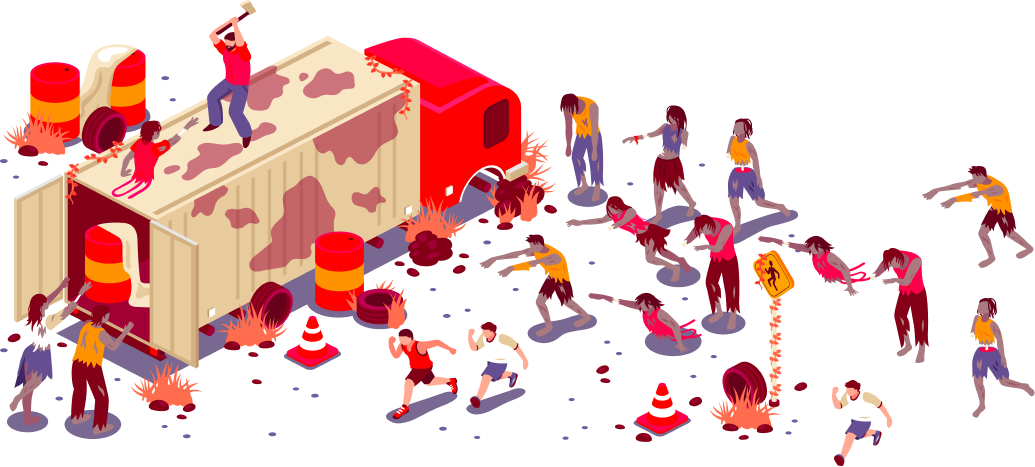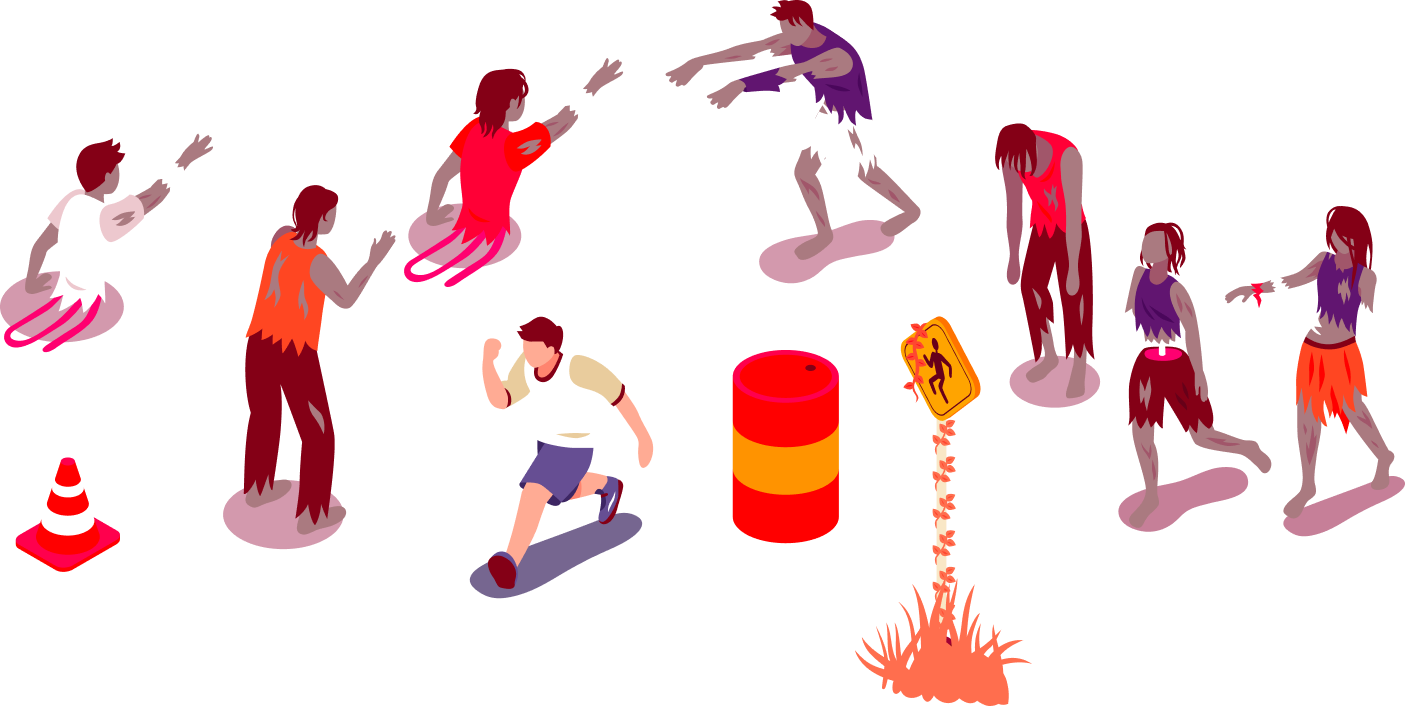Introduction
The recent years have seen many problems afflicting the world, including the Covid-19 pandemic, wars, and changes in the social and economic structures that continue to shape the cultural, social and economic landscape globally. However, the situation could potentially worsen. What if a new epidemic arises that turns people into zombies, or a war breaks out between the living and the dead? To determine the safest place in Italy in case of a hypothetical zombie apocalypse, we analysed various factors across five categories: Vulnerability, Hideouts, Supplies, Safety and Mobility. Based on our findings, we have identified the safest place in Italy. Whether you live in Rome, Milan, Naples or Turin - we’ve got you covered. Therefore, if you do not reside in the safest city or province, it may be wise to consider relocation in the event of a global zombie outbreak.

Categories of data
The five categories each contain a number of data points that are considered to be representative of the category in question. Each of these underlying data points has been analysed and indexed for each city, after which an average score has been calculated. The following is an overview of the underlying data used for each category:
-

Vulnerability
Indicators: POPULATION, DENSITY, MIGRATION RATE, NUMBER OF PEOPLE WORKING IN THE HEALTHCARE SECTOR, MORTALITY RATECertain places are naturally predisposed to epidemics and their rapid spread. Let's think about recent years: high population density, influx of tourists, percentage of chronic diseases in the population, and even the risk index for disasters. We have used all of this data to calculate which municipality is the most vulnerable to a hypothetical zombie invasion.
-

Hideouts
Indicators: NUMBER OF DWELLINGS, NUMBER OF FARMS, GREEN AREAS'Apocalypse' doesn't just mean astronauts embarking on a heroic mission to destroy an asteroid heading towards Earth. Often, it's more like playing hide-and-seek. It is important, therefore, to find the best, most protected, or isolated place to save one's life and be able to cultivate food. This index shows how many hiding places there are in the region.
-

Supplies
Indicators: NUMBER OF FARMS, LAND FOR CROPS AND WILD FRUITSYes, you will need many things: food, fuel, tools, weapons, clothing, medicine, and perhaps even a goldfish! It is preferable to have supply structures nearby so that you can borrow everything you need as soon as possible (which you will have to return later, though!).
-

Mobility
Indicators: CARS PER 1000 INHABITANTS, MOTORCYCLES PER 1000 INHABITANTS, TRANSPORT DEMANDYou may also need to travel extensively in search of survivors, supplies, or a better place. Therefore, it is important that transportation becomes your ally, and that the road network is optimal.
-

Safety
Indicators: CRIME RATE, NUMBER OF ARMED CRIMESSpeaking of weapons and self-defense tools, we have identified areas with more weapons, specialized shops, and military bases. Now we know who is more likely to have a zombie roast!

Ravenna ranked as the safest place to be
According to our findings Ravenna comes up on top in terms of being the province with the highest zombie resistance. But what makes this North-East province near Bologna and Florence well poised to fight off a wave of zombies or avoid them appearing all together? District achieved relatively high scores in almost all categories. And despite the fact that in some categories such as safety the province has a pretty low score, it has the highest average score of all. This important indicator do not cancel out the fact that the province is quite highly rated in vulnerability (No.10) and hideouts (No.3). So in case of zombie threat, Ravenna is a place where you can feel safe and hidden. Especially considering that the entire North-East is a relatively safe place. But we will return to this later.
Stay away from Lombardy and provinces in Central regions
The three total lowest rankings are located near Milan. Among them is Varese at dead last (No. 107). The province achieved one of the lowest overall score in few categories like hideouts (No. 105), supplies (No. 105) and mobility No. 106). Basically Lombardy is a place you don't want to be in when dozens of zombies are coming.
This region hosts 3 of 10 provinces with the lowest rankings. Monza e della Brianza (No.2) and Como (No. 9) have less-than-average rankings in all categories, which makes this dense region the worst place to hang out.
Some of the country's central provinces would also be at risk in the event of a zombie apocalypse. We are primarily talking about Teramo (No. 98), Napoli (No. 102) and Roma (No. 105). All three locations form a geographical triangle like the Bermuda triangle, which is better not to get into.
Capital city of Rome
As already mentioned, the central region is not very safe in case of a zombie invasion. And Rome is one of the most vulnerable places in Italy. The capital is third from the bottom, scoring very poorly in most categories.
Rome is a very densely populated city and is vulnerable to the threat of the spread of the virus, which is indicated by a low score in this category (1.8 which is 106th place in the list). But at the same time, the capital ranks 3rd among all in the safety category, so that can give you some extra time to think about what to do in such an unpleasant situation.
Go to the North-East
4 of the top 10 departments are located in the North-East. Provinces such as Trieste, Belluno, Reggio nell'Elia and the aforementioned Ravenna score quite well in various categories, but they are also very conveniently located.
On the one hand, there is a natural border (Alpes) that protects against threats from the North, and Adriatic Sea that helps with zombies from South-East. So living somwhere from Verona to Udine can not only bring you pleasure now but also save lives in the case of a zombie apocalypse.
Data/
Metho
dology
All data has been collected and processed from The Italian National Institute of Statistics. The latest data available has been used for each datasource. Min-max normalisation has been used to index the data sources in question. This method of indexing allows us to convert any kind of data to a value between 1-10, where 1 represents the lowest / worst value and 10 the highest / best value within the categories in question. This means that the higher a score an area achieves, the better it is relative to the others. To ensure a precise and representative result as possible, all departments missing more than two data sources have been removed from the Quality Index.

